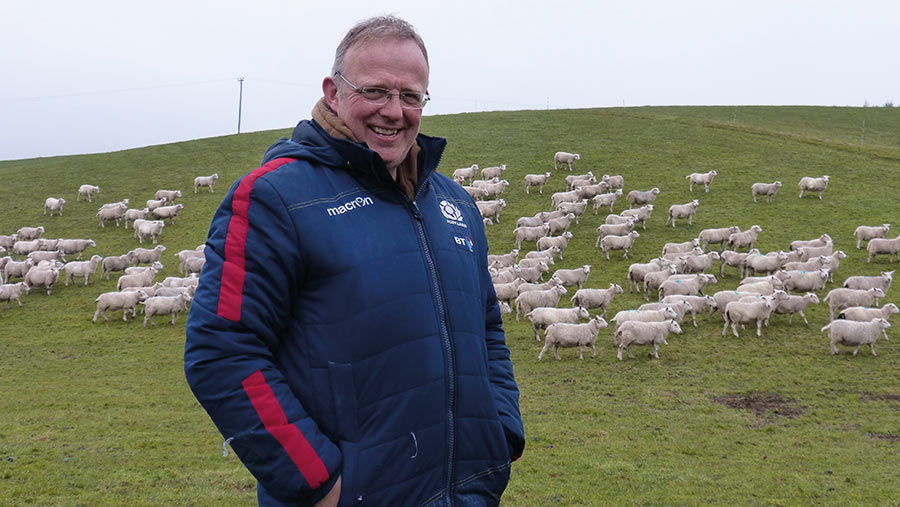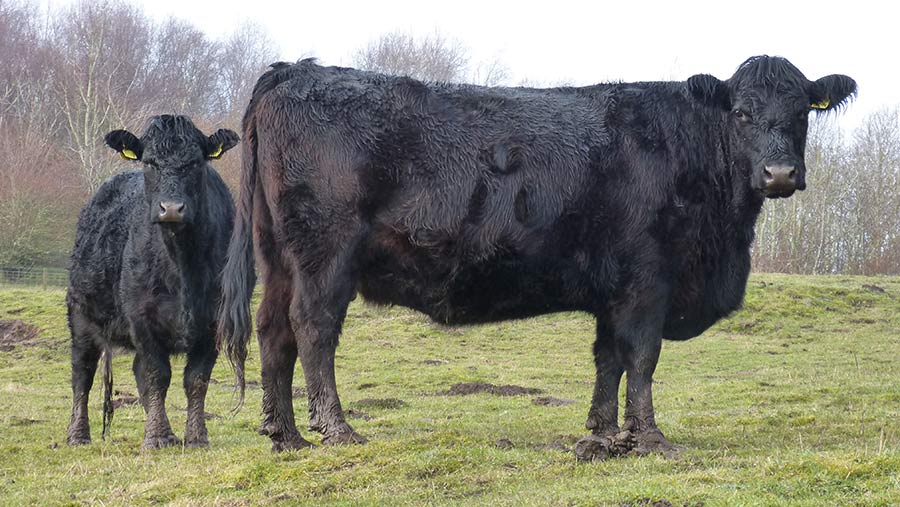Upland beef and sheep farm aims for 30-hour week
A beef and sheep farming new entrant has committed to an average farming week of 30 hours to maximise off-farm income and complement earnings from managing 210 livestock units.
At 53 years old, Michael Blanche of Culteuchar Farm, Perth had an epiphany last year. The clock was ticking, and he didn’t want to spend retirement “at the roadside in a cardboard box”.
See also: Tips for better time management on the farm
Mr Blanche started farming 50 sheep in 2003 before moving to the tenancy at Culteuchar, near Forgandenny, with 650 ewes and sub-let grazing ground for cattle.
“I’ve been here 12 years and, optimistically, have 12 years left,” he explains. “I spend so much time pratting about finding basic implements, I must change. And I’d like a holiday now and again if possible.”
Farm Facts

Michael Blanche © MAG/Michael Priestley
- 550 ewes and 200 hoggs
- 184ha (455 acres) of grassland
- Owns a 65% share in a growing suckler herd of 45 Angus cross Welsh black females
- Additional flock contract-farmed for neighbour
- Tenancy is across two farms, Culteuchar and Netherholm
- Land rises to 313m on 100ha (247 acres) of grassy hill at Culteuchar, with some heather at the top
- Modern limited-duration tenancy
Why is time important?
With a rent to pay and 130-140 livestock units at home, (he is currently aiming for a system of 60 suckler cows and 600 lambing ewes), Mr Blanche has always needed off-farm income for financial security.
Costs have been controlled by rotational grazing, outdoor lambing and cutting out fertiliser. He has been farming organically since 2016.
He says working more efficiently should allow him to do the following:
- Find more time for off-farm consultancy work Mr Blanche spent a total of 14 years working for land agent Davidson and Robertson, SAC Consulting and Quality Meat Scotland
- Spend more time growing his podcast The Pasture Pod was launched in 2017 and brings in £400 a month
- Make farming easier Following a hip operation in 2022, he is conscious that physical work will get harder in the years ahead
- More family and leisure time Meals out and trips away with wife Kate and his four children, Jess, Seamas, Calum and Keres
- Continue contract farming He currently manages a flock of 600 females for a neighbouring farmer
- Take advantage of opportunities if they arise A low-cost base for his lamb enterprise (£1.97/kg in 2018-19) and a total variable cost of 83p/kg, driven by rotational grazing, means capital is not tied up in high-cost structures. This makes tendering for more land a more viable option, should it become available
- Grow cow numbers Valuing his suckler herd (see “Suckler cow system”), which is owned in a 65:35 profit-share with a neighbour, on a herd basis, means growing numbers can be written off as a cost. The herd will hopefully be cashed in at retirement.

Angus cross Welsh Blacks at Ardgavie @ MAG/Michael Priestley
Suckler cow system
- Cows winter, calve and graze outside all year round
- Four bales of haylage for each cow (costed at £35 a bale) gives a total feed cost of £140 a cow for November and March
- Neither Michael Blanche nor his neighbour owns a tractor. His neighbour owns a telehandler for placing bales for winter
- Calves were sold at weaning in October 2022 for £625 a head
- Cows graze the neighbour’s hill on 1ha (2.5 acre) blocks from November to late February
Podcast series
Last year, Mr Blanche applied to the Frank Parkinson Trust for support with a podcast project called “It’s About Time” after an Australian farmer on Facebook suggested UK farmers need to run 5,000-6,000 ewes to a labour unit.
Mr Blanche spoke to farmers and advisers around the UK and across the world online, discussing time management issues and strategies.
Time targets
Since completing the podcast series, he has set himself the following targets:
- Cut about 15 hours out of a typical average week, to 35, and eventually 30 hours
- A maximum of three hours of farming is allowed on a typical day
- One day a fortnight can be full time
- Occasional infrastructure projects are a “free pass” and do not count
- Four weeks of lambing and calving can be full time
- Leave five or six hours a day most days for other activities.
Techniques
To make this dream a reality, Mr Blanche has made a conscious decision to make to-do lists, tidy his three small sheds and stop “wasting time”.
Among the changes he has already made are:
- Fewer mob groups Priority groups such as heifers and ewe lambs will be run with mature stock, to cut group numbers from six down to four. In winter, there will be a mob of ewes and a mob of ewe lambs. Before tupping, the three groups will reform (leans, fatter sheep and ewe lambs). If adding another stock group costs 15 minutes – and it will probably add twice that, he says – this adds up to 37.5 hours over a 150-day winter, the equivalent of a working week.
- Lists and priorities A jobs list for the following week is made every Friday. It is important to “plan it before you’re in it”. Each day has three priority jobs (“gold”, “silver” and “bronze”). This list goes in a diary with space at the bottom of each page to tabulate jobs according to importance and urgency.
- Hot spots Each job on the farm has a storage area given to it, for example, fencing gear, grazing equipment and so on.
- Tidying for 25mins Tidying small areas around the farm for short periods has helped organise clutter and find lost tools. Spending longer periods of time tidying and sorting seems oppressive and is prohibitive to making a start.
Industry problem
Mr Blanche says several farmers he spoke to had similar issues with time management. Many farms are “time sponges” and do not give you a chance for a break, he explains.
“I was full-time farming in 2018 and with the contract shepherding ran 1,400 ewes, but it didn’t do me any good,” he admits.
He has focused on his strengths to pay rent and still manage to grow equity every year.
“When I got here, the overdraft we were promised didn’t materialise, so I sold my subsidy entitlements and managed off £1/acre subsidy for a while before the Basic Payment Scheme started. I was so desperate to farm, I had to make it work and this focused my mind.
“I’m naturally lazy, so checking ewes once a day and outdoor lambing appeals to me. But this means I must maximise the effort I do put in. I just hope I can manage myself better.”
The numbers
- £1.20 Bought-in feed cost a ewe, which was £1,000 for two tons of bagged concentrate for growing replacement ewes
- 50kg Average mature ewe weight. Sheep scan at about 150%
- £5.19 Last year’s flock health spend (a ewe)
- 350kg How much liveweight the farm produced per hectare last year (hill ground counts for 20% of actual hectarage). This is up from 200-300kg when he started farming at Culteuchar.
- 83% Lamb survival rate from scanning to marking
